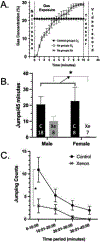Effects of inhaled low-concentration xenon gas on naltrexone-precipitated withdrawal symptoms in morphine-dependent mice
- PMID: 38150894
- PMCID: PMC10841182
- DOI: 10.1016/j.drugalcdep.2023.110967
Effects of inhaled low-concentration xenon gas on naltrexone-precipitated withdrawal symptoms in morphine-dependent mice
Abstract
Background: Opioid withdrawal symptoms (OWS) are highly aversive and prompt unprescribed opioid use, which increases morbidity, mortality, and, among individuals being treated for opioid use disorder (OUD), recurrence. OWS are driven by sympathetic nervous system (SNS) hyperactivity that occurs when blood opioid levels wane. We tested whether brief inhalation of xenon gas, which inhibits SNS activity and is used clinically for anesthesia and diagnostic imaging, attenuates naltrexone-precipitated withdrawal-like signs in morphine-dependent mice.
Methods: Adult CD-1 mice were implanted with morphine sulfate-loaded (60 mg/ml) minipumps and maintained for 6 days to establish morphine dependence. On day 7, mice were given subcutaneous naltrexone (0.3 mg/kg) and placed in a sealed exposure chamber containing either 21% oxygen/balance nitrogen (controls) or 21% oxygen/added xenon peaking at 30%/balance nitrogen. After 10 minutes, mice were transferred to observation chambers and videorecorded for 45 minutes. Videos were scored in a blind manner for morphine withdrawal behaviors. Data were analyzed using 2-way ANOVAs testing for treatment and sex effects.
Results and conclusions: Xenon-exposed mice exhibited fewer jumps (P = 0.010) and jumping suppression was detectible within the first 10-minute video segment, but no sex differences were detected. Brief inhalation of low concentration xenon rapidly and substantially attenuated naltrexone-precipitated jumping in morphine-dependent mice, suggesting that it can inhibit OWS. If xenon effects translate to humans with OUD, xenon inhalation may be effective for reducing OWS, unprescribed opioid use, and for easing OUD treatment initiation, which could help lower excess morbidity and mortality associated with OUD.
Keywords: Inhalation Therapy; Medications for opioid use disorder; Opioid withdrawal; Sympathetic nervous System; Xenon.
Copyright © 2023 Elsevier B.V. All rights reserved.
Conflict of interest statement
Declaration of Competing Interest Drs. Kaufman and Meloni are inventors on a patent assigned to The McLean Hospital Corporation covering the use of inhaled xenon gas to treat psychiatric and substance use disorders. Dr. Bogin is an inventor on a patent assigned to Nobilis Therapeutics, Inc., covering the use of a xenon inhalation system to treat brain disorders. Drs. Kaufman and Meloni received past compensation from Nobilis Therapeutics, Inc. Drs. Kaufman and Meloni received an award from the National Institute on Drug Abuse in 2020 by winning “Start a SUD Startup 2020” Challenge Award. No conflicts are declared for Drs. Qrareya and Paronis.
Figures

Similar articles
-
Comparison of the opioid receptor antagonist properties of naltrexone and 6 beta-naltrexol in morphine-naïve and morphine-dependent mice.Eur J Pharmacol. 2008 Mar 31;583(1):48-55. doi: 10.1016/j.ejphar.2008.01.004. Epub 2008 Jan 24. Eur J Pharmacol. 2008. PMID: 18275956 Free PMC article.
-
The role of opioid antagonist efficacy and constitutive opioid receptor activity in the opioid withdrawal syndrome in mice.Pharmacol Biochem Behav. 2011 Oct;99(4):671-5. doi: 10.1016/j.pbb.2011.06.025. Epub 2011 Jun 29. Pharmacol Biochem Behav. 2011. PMID: 21736895 Free PMC article.
-
Probing different paradigms of morphine withdrawal on sleep behavior in male and female C57BL/6J mice.Behav Brain Res. 2023 Jun 25;448:114441. doi: 10.1016/j.bbr.2023.114441. Epub 2023 Apr 17. Behav Brain Res. 2023. PMID: 37075956 Free PMC article.
-
Adjunctive memantine for opioid use disorder treatment: A systematic review.J Subst Abuse Treat. 2019 Dec;107:38-43. doi: 10.1016/j.jsat.2019.10.003. Epub 2019 Oct 20. J Subst Abuse Treat. 2019. PMID: 31757263
-
Opioid Withdrawal Precipitated by Long-Acting Antagonists.J Emerg Med. 2020 Feb;58(2):245-253. doi: 10.1016/j.jemermed.2019.12.015. Epub 2020 Jan 28. J Emerg Med. 2020. PMID: 32005608 Review.
Cited by
-
Xenon gas as a potential treatment for opioid use disorder, alcohol use disorder, and related disorders.Med Gas Res. 2025 Jun 1;15(2):234-253. doi: 10.4103/mgr.MEDGASRES-D-24-00063. Epub 2025 Jan 13. Med Gas Res. 2025. PMID: 39812023 Free PMC article. Review.
References
-
- Abiko LA, Dias Teixeira R, Engilberge S, Grahl A, Mühlethaler T, Sharpe T, Grzesiek S, 2022. Filling of a water-free void explains the allosteric regulation of the β1-adrenergic receptor by cholesterol. Nat. Chem 14, 1133–1141. - PubMed
-
- Adolph O, Köster S, Georgieff M, Bäder S, Föhr KJ, Kammer T, Herrnberger B, Grön G, 2010. Xenon-induced changes in CNS sensitization to pain. Neuroimage 49, 720–730. - PubMed
-
- Ahmad FB, Cisewski JA, Rossen LM, Sutton P, 2023. Provisional Drug Overdose Death Counts. National Center for Health Statistics.
-
- Beardsley PM, Ratti E, Balster RL, Willetts J, Trist D, 2002. The selective glycine antagonist gavestinel lacks phencyclidine-like behavioral effects. Behav. Pharmacol 13, 583–592. - PubMed
MeSH terms
Substances
Grants and funding
LinkOut - more resources
Full Text Sources
Medical

